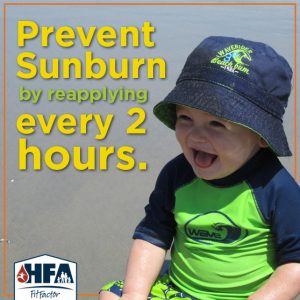Summer is in full swing, and with so many fun things to do outside, it’s easy to act first – think later. But the hot summer months bring a certain level of risk, so here are a few precautions to take before heading outside.
Heat and Sun: We’ve all been there – we spend the day consumed with our favorite summer activity and then find out later that we’ve got a massive sunburn or a heat-related illness. To prevent sunburns and protect against skin diseases, ensure that you apply sunscreen with SPF 15 or  higher 30 minutes before going outside and reapplying every two hours – even on cloudy days. Combine sunscreen with other protection, such as wearing light long-sleeve shirts, hats, and sunglasses and find some shade, particularly in the hottest time of the day when the sun’s UV rays are the strongest.[1]
higher 30 minutes before going outside and reapplying every two hours – even on cloudy days. Combine sunscreen with other protection, such as wearing light long-sleeve shirts, hats, and sunglasses and find some shade, particularly in the hottest time of the day when the sun’s UV rays are the strongest.[1]
Heat-related illnesses are caused when one is exposed to abnormal or prolonged amounts of heat without relief or proper fluid intake. Children and teens produce more heat, sweat less, and adjust more slowly to heat than adults so make sure that they (and you) consume plenty of fluids and take breaks in the shade. Pay close attention to warning signs of heat-related illnesses like muscle cramps, fever, and nausea.
Physical Activity: When making your summer plans, be sure to check with your physician or physical therapist before beginning a new physical activity. Remember to discuss your factor schedule with your physician and adhere to it. Heat and sun can tire our bodies more quickly and easily than during mild temperatures, making us more prone to injuries. Heat can also make an active bleed worse or cause a recently resolved bleed to start again.[2] Staying well hydrated will help to prevent injuries. Water is needed to maintain cellular activity, to carry nutrients to your cells, to maintain normal blood pressure and body temperature, and to act as a lubricant in joints and other parts of the body.
Mosquitos and Flies: As we all know, mosquitos and black flies can be bothersome, sometimes infuriating, so don’t forget insect repellent when you head to the park, beach or trails. There are also plenty of other ways to ward off bugs, like mosquito coils, netting, and torches. The Environmental Protection Agency has an online tool to help you find the repellent that is best for you and your family.
Ticks: In addition to mosquitos, there is a rising tick population in the U.S., as their geographical regions expand north.[3] Certain ticks have the potential to transmit human disease, so it’s important to take precautions before and after you’ve been outside. Use repellent that has at 20% or more DEET, picaridin, or IR3535 on exposed skin for adults and less than 30% concentration for kids. Give ticks as little access to you as possible: avoid walking in high grass or brush and try to stay in the center of the trail. When you return home, bathe or shower and conduct a full-body tick check in front of a mirror. Parents should examine their children and pets thoroughly. More resources on tick prevention, removal and diseases can be found at the CDC’s website.
Poisonous Plants: Be aware of other summer risks, such as bee stings and poisonous plants. Keep an eye out for poison ivy, oak, and sumac – all of which can cause a rash if the leaves come in contact with exposed skin. Fortunately, it’s not contagious, but make sure to wash skin and clothing immediately after contact. Apply hydrocortisone cream to calm the itch.
Bees: Bees are attracted to flowers, so don’t dress in bright, floral clothing and keep all food and drink containers closed. If someone is stung, apply a cold compress, hydrocortisone cream, and an antihistamine to reduce swelling. Skin reactions are normal but be aware of allergic reactions, which require immediate medical attention.
Indeed, summer brings a certain number of concerns, but don’t let them dissuade you from getting outside and staying active! Be prepared by taking insect repellent, sunscreen, a first aid kit and plenty of water with you as embark on your adventures. Remember to check with your physician if you have any concerns about your summer activities as they relate to your individual health. For more resources on summer safety for children and families visit CDC.gov.
*While extensive efforts are made to ensure accuracy of the content of each FitFactor post, these entries are not intended to be construed as medical advice or the official opinion/position of HFA, its staff, or its Board of Directors. Readers are strongly encouraged to discuss their own medical treatment with their healthcare providers.
[1] https://www.cdc.gov/family/kids/summer/index.htm
[2] http://www.haemophiliacare.co.uk/haemophilia_health/heat-and-cold.html
[3] https://www.theguardian.com/environment/2015/jul/28/tick-populations-booming-due-to-climate-change



